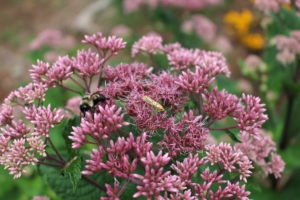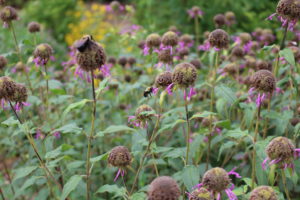Native Plants for Bees & Other Pollinators
go.ncsu.edu/readext?624227
en Español / em Português
El inglés es el idioma de control de esta página. En la medida en que haya algún conflicto entre la traducción al inglés y la traducción, el inglés prevalece.
Al hacer clic en el enlace de traducción se activa un servicio de traducción gratuito para convertir la página al español. Al igual que con cualquier traducción por Internet, la conversión no es sensible al contexto y puede que no traduzca el texto en su significado original. NC State Extension no garantiza la exactitud del texto traducido. Por favor, tenga en cuenta que algunas aplicaciones y/o servicios pueden no funcionar como se espera cuando se traducen.
Português
Inglês é o idioma de controle desta página. Na medida que haja algum conflito entre o texto original em Inglês e a tradução, o Inglês prevalece.
Ao clicar no link de tradução, um serviço gratuito de tradução será ativado para converter a página para o Português. Como em qualquer tradução pela internet, a conversão não é sensivel ao contexto e pode não ocorrer a tradução para o significado orginal. O serviço de Extensão da Carolina do Norte (NC State Extension) não garante a exatidão do texto traduzido. Por favor, observe que algumas funções ou serviços podem não funcionar como esperado após a tradução.
English
English is the controlling language of this page. To the extent there is any conflict between the English text and the translation, English controls.
Clicking on the translation link activates a free translation service to convert the page to Spanish. As with any Internet translation, the conversion is not context-sensitive and may not translate the text to its original meaning. NC State Extension does not guarantee the accuracy of the translated text. Please note that some applications and/or services may not function as expected when translated.
Collapse ▲Planting native plants is a great way to support bees and other pollinators. Native plants have developed to local climate and soil conditions over thousands of years, along with native bee species. Thus, the bees and other native pollinators are well-adapted to coexist with native plants. Gardeners can support bees by planting native plants in their landscapes.

Pollinator activity on Joe Pye Weed, Eutrochium purpureum.
If you’re planning to start a pollinator garden to support bees, there are a few places to start. Read on for details, and be sure to check the end of the article for more resources.
Plant flowers that bloom throughout the year. Honeybees and bumblebees are generalists, which means they feed on a variety of plants. Other bees are specialists and prefer to feed on specific plants during shorter periods of time. You can support bees that are generalists by planting a variety of flowers that bloom through the season. Check the “Top 25 Native Pollinator Plants for North Carolina” list to get ideas about what to plant for pollinators throughout the seasons. Selecting Plants for Pollinators also provides good information about bloom time for various plants that are native to the southeastern U.S. For further assistance with plant selection, try the NC Extension Gardener Plant Toolbox.
Use a variety of flowering plants in your garden. Pollinators will benefit from variety in your garden, and using a selection of plants will attract a wider diversity of bees to your garden. In general, bees prefer flowers that are:
- Bright white, yellow, blue, or UV in color
- Nectar guides are present on the flowers – these are markings on the flower that provide guides to where the nectar can be found.
- The flowers have a fresh, mild, and pleasant odor.
- There is usually nectar present, but a limited amount of pollen that is often sticky and scented.
- The flowers are shallow. There may be a landing platform to help bees feed, or the flowers may have a shallow, tubular shape.
Try to choose plants with different flower structures – some may have flowers that occur in spikes (e.g. Agastache or Solidago), others have composite flowers (e.g. asters), while others have flowers that occur on umbels (e.g. Joe Pye Weed). Check out the photos on the NC Extension Gardener Plant Toolbox to help you determine what the flowers of different plants look like.
Place flowering plants in clusters in your landscape. Having flowers in bunches in the garden makes it more efficient for pollinators to forage. There is also less risk of predation when bees do not have to travel across open areas to find flowers to feed on.

Bee activity on Agastache.
Provide habitat for bees. Bees have a variety of nesting habitats. Some bees nest in the ground, they will likely choose a sunny spot with bare soil. Other bees are cavity nesters, meaning they will nest in holes. These bees may choose dry, hollow stems or dead wood to nest in. Leaving some dead branches in your garden can provide a place for these bees to live. In addition, using native grasses in the landscape can provide cover for bees and other pollinators. Leave the grasses in your garden through the winter. When it’s time to cut the grasses back in the spring, lay the clippings in your yard as a mulch. This will allow any insects present to emerge in the spring, and may also help suppress weeds.
You can manage your garden to provide habitat for stem-nesting bees by cutting back stems of perennial plants that bloomed last season to a height of 12 to 24 inches in the winter. Leave the stems throughout the next season as habitat for pollinators. Read more about this management strategies and view a video desribing them here.
Provide a source of water. Like other animals and insects, bees need water to survive. Having a source of water present in or near your garden will ensure that you have happy, healthy bees. Butterflies also use water, but they tend to like puddling in muddy areas. Incorporating sand in butterfly water areas can also provide them with minerals they need. Anywhere you incorporate water, be sure to refresh the water every few days to reduce the possibility of providing a place for mosquitoes to breed in your yard.
Limit pesticide use. Many insecticides are non-selective and will harm a large range of insects, including bees and other pollinators. Reduce and eliminate the use of these chemicals in your yard as much as possible to support bees. When it is necessary to use an insecticide, try to apply when plants are not blooming, or at a time when bees are less active (this is usually in the very early morning or evening).

Bees on bee balm (Monarda didyma).
There are lots of great resources for you to learn about native plants, bees, and other pollinators! Here are some to get you started:
- The Native Plants Chapter of the NC Extension Gardener Handbook
- The Bees of North Carolina
- Book: Pollinator Gardening for the South: Creating Sustainable Habitats
- Landscaping for Wildlife with Native Plants
- How to Create Wildlife-Friendly Landscapes (includes step-by-step design instructions)
- Butterflies in Your Backyard
- NC Native Plant Society
- Chatham Mills “Pollinator Paradise” Garden in Chatham County




